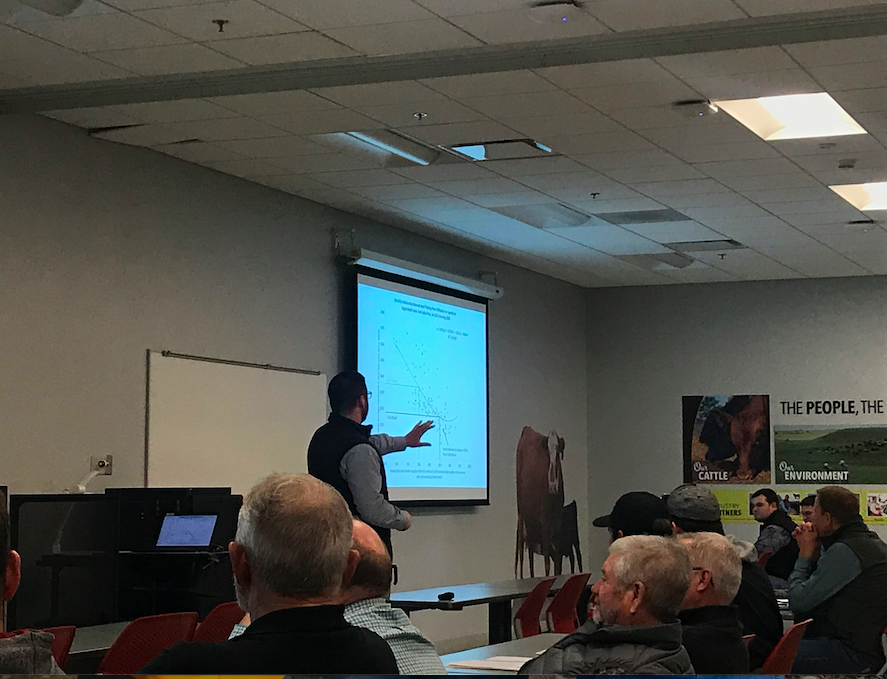Showcase presents beef research from Iowa State
Amber Friedrichsen/ Iowa State Daily
Lee Schulz, a professor in economics, discussed cattle markets at Wednesday’s Beef Nutrition Showcase.
December 4, 2019
After farm tours of the Iowa Beef Center, attendees gathered to learn about beef research being conducted at Iowa State on Wednesday at the Beef Nutrition Showcase.
The showcase took place at the Hansen Agriculture Student Learning Center, and those in attendance got to hear from numerous speakers who specialize in beef. Topics of interest included cattle stress and behavior, the role of vitamins and minerals in beef nutrition and the future of cattle farming.
To start off the event, Erin Deters, a graduate student in animal science, presented the results of her research regarding stress on beef during transit.
“The feedlot receiving period is one of the most stressful times in the life of a beef animal,” Deters said. “We still expect that calf to eat enough feed, gain enough weight and remain healthy when it gets to the feedlot.”
Deters said there are practices farmers can take to promote health in their cattle once they arrive to their feedlot — things like weaning prior to transporting, giving vaccines and exposing them to new feed. However, few operations have access to all of these factors, resulting in a negative influence on the animals.
In addition to improper pre-transportation precautions, when cattle are being transported they are at risk of physical and psychological stress.
“Transportation has been shown to predispose cattle to bovine respiratory disease, which is often referred to as ‘shipping fever,’” Deters said. “Costs that go along with bovine respiratory disease include the direct cost of treatment as well as lost performance and decreased carcass quality.”
To prevent the harm done to cattle when they are transported, Deters discussed the role that supplementing antioxidants into the animals’ diets plays in their health. Antioxidants help protect cells in the body from oxidation by free radicals.
“A free radical is essentially an unstable molecule that you can think of as a bully on the playground,” Deters said. “Instead of the bully stealing toys, he likes to steal electrons from healthy cells. [An antioxidant] is a compound or an enzyme that will give off one of its own electrons to neutralize that free radical before it can cause damage to our healthy cells.”
By incorporating antioxidants into cattle diets with vitamin C supplements, they improved their average daily gain and supported their growth. Deters said that by inhibiting oxidation, animals have more energy to use to grow as opposed to fighting off free radicals.
Deters pointed out that transit is unavoidable in the beef industry and sometimes negatively impacts beef quality and performance. Understanding how cattle undergo stress during transit can help producers find ways to minimize the impact of the stress.
Once cattle have been transported to the farm, their health is still very much considered.
Katherine VanValin is a postdoctoral research associate in the animal science department who has done research in precision livestock farming.
“Precision livestock farming, for me, is this idea of moving from whole-herd, whole-pen-based management to the management of that individual animal within the pen,” VanValin said. “I think that we can more strategically manage those cattle.”
One aspect of precision livestock farming is nutrition. VanValin said there are improvements that can be made when considering the inconsistency between feed created for cattle and what they actually eat.
“You’ve got the diet that the nutritionist formulates, the diet that goes in the mixer, the diet that gets delivered to the bunk and then the diet that ultimately cattle eat,” VanValin said. “There may be some opportunities to decrease the variation across these diets.”
In order to do this, VanValin said there are technologies to monitor feed within feedlots.
There are also technologies being used to monitor animal health, such as cameras for detecting sick behavior in cattle. VanValin described the results of a study using the camera technology.
“You’ll see that they’ve got their heads down, they’re salivating, they’ve got snotty noses and they don’t feel good at all,” VanValin said.
The technology detected the cattle’s ill behavior and then notified VanValin’s phone that there were animals in need of treatment.
When cattle are healthy and perform effectively, they are eventually able to be processed and have their products sold to consumers. Lee Schulz, an associate professor in economics, talked about the future of cattle markets and what producers can expect.
“I’m actually kind of optimistic when we look at 2020,” Schulz said. “When you look at future prices now, they’re all really suggesting higher prices for fed cattle, feeder cattle and calves.”
The best demand years occurred when consumers ate less, but paid more for beef, Schulz said. Now, people are seeing “flat consumption,” meaning that demand has increased from past years and is remaining steady.
“[We] have relatively large supplies,” Schulz said. “To see higher prices, we are going to continue to have to see high demand. I think this gives producers a lot of opportunities to offset a lot of potential risk.”







